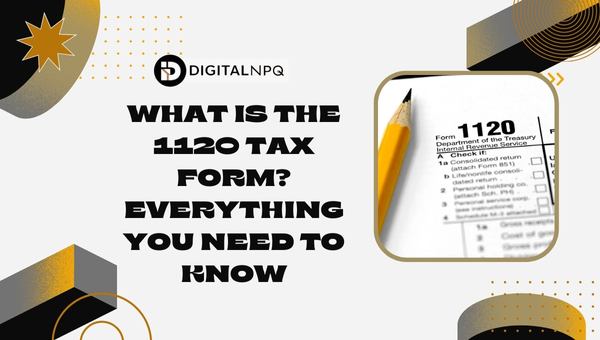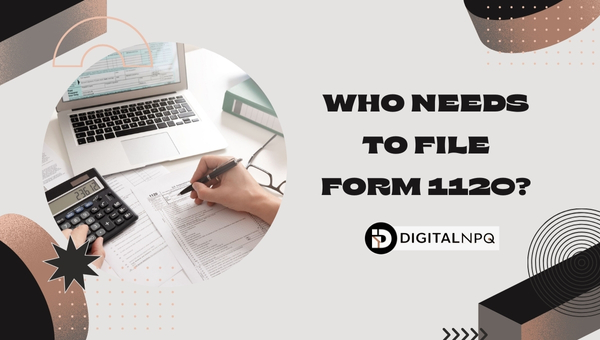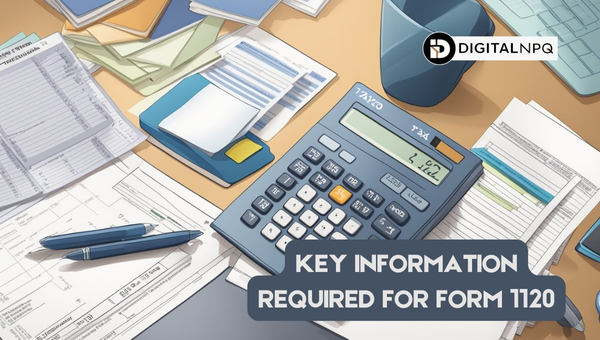What is the 1120 Tax Form? Everything You Need to Know

Knowing what the 1120 tax form is is essential for any business owner, even though navigating the world of corporate taxes can be confusing. In this article, we’ll delve into the specifics of Form 1120, who needs to file it, the key information required, and how to fill it out.
We’ll also compare it with Form 1120-S to help you make informed decisions. Let’s dive in and simplify your tax filing process!
Understanding Form 1120
Form 1120, also known as the U.S. Corporation Income Tax Return, is the document that C corporations use to report their financial activities to the Internal Revenue Service (IRS).
Its primary purpose is to calculate the corporation’s tax liability, which is the amount of tax owed based on the corporation’s taxable income.
The form is essential for corporations to comply with federal tax regulations. It requires corporations to report various types of financial information, including income, gains, losses, deductions, and credits.
This comprehensive reporting ensures that corporations are accurately taxed on their earnings.
Filing Form 1120 is a crucial step for any C corporation, as it helps the IRS assess the corporation’s financial health and tax obligations. By accurately completing this form, corporations can avoid potential penalties and ensure they meet their tax responsibilities.
In essence, Form 1120 serves as the cornerstone for a corporation’s annual tax reporting and compliance. Understanding its purpose and requirements is fundamental for any corporation aiming to navigate the complexities of federal tax laws effectively.
Who Needs to File Form 1120?
Understanding who needs to file Form 1120 is crucial for businesses. This section will help you determine if your entity falls under the requirements.

Eligibility Criteria
Not all businesses are required to file Form 1120. The form is specifically for certain types of entities.
- C Corporations: These corporations, which are separate tax entities from their owners, must file Form 1120 to report income, gains, losses, deductions, and credits.
- Limited Liability Companies (LLCs): LLCs that have elected to be taxed as corporations also need to file this form. However, single-member LLCs usually report income on the owner’s personal tax return.
- Farming Corporations: Corporations involved in farming activities must file Form 1120 to accurately report their income or losses.
- Foreign-Owned Domestic Disregarded Entities: If a foreign entity owns a domestic disregarded entity, the domestic entity must file Form 1120 along with Form 5472 to report transactions with its foreign owner.
It’s important to note that all domestic corporations are required to file, even if they do not have taxable income for the year. This ensures compliance with federal tax regulations.
Also Read: Direct Deposit Payment Eligibility 2024: Must-Know Criteria
Key Information Required for Form 1120
When preparing to file Form 1120, gathering the necessary information is crucial. Details about your business, income, deductions, balance sheet, and tax credits need to be provided accurately. Let’s delve into each of these sections.

Business Information
To start, you need to provide essential business information on Form 1120. This includes:
- The official name and address of the corporation.
- The Employer Identification Number (EIN).
- The date of incorporation.
- The principal business activity and corresponding business code.
This information helps the IRS identify your corporation and understand its primary operations.
Income and Deductions
Next, you must report all sources of income. This includes:
- Gross receipts or sales.
- Dividends.
- Interest income.
- Capital gains.
In addition, the deductions section allows you to list business expenses such as salaries, rent, and depreciation. These deductions are subtracted from your total income to determine your taxable income. Accurately reporting income and deductions is vital for calculating your tax liability.
Balance Sheet Details
Form 1120 also requires balance sheet details if your total assets or gross receipts exceed $250,000. You need to complete Schedule L, which includes:
- Total assets.
- Liabilities.
- Shareholder equity.
This provides a snapshot of your corporation’s financial position at the end of the tax year, giving the IRS a clear view of your financial status.
Tax and Refundable Credits
Finally, you need to cover tax and refundable credits sections. This involves:
- Calculating the corporation’s tax liability.
- Claiming any refundable credits.
Various tax credits, such as those for research and development, can reduce your overall tax burden. Ensure you accurately complete these sections to take full advantage of any available credits.
By meticulously providing this information, you can ensure that your Form 1120 is complete and accurate.
Also Read: Anchor Program New Jersey: Your Guide to Property Tax Relief
How to Fill Out Form 1120?
Filling out Form 1120 can seem challenging, but with the right guidance, it becomes manageable. This section will guide you through the process step-by-step, making it easier to complete and submit the form correctly.

Step-by-Step Instructions
To ensure you fill out Form 1120 accurately, follow these detailed steps:
- Gather Financial Records:
- Collect all necessary documents such as income statements, balance sheets, and expense records.
- Complete Business Information:
- Fill in the corporation’s name, address, Employer Identification Number (EIN), and other identifying details.
- Report Income:
- Enter the total income from all sources in the income section of the form.
- List Deductions:
- Document all allowable deductions to calculate the taxable income accurately.
- Prepare Balance Sheet:
- If applicable, complete Schedule L with detailed balance sheet information, including assets and liabilities.
- Calculate Tax Liability:
- Determine the tax owed based on taxable income using the provided tax tables in the form’s instructions.
- Review and Submit:
- Double-check all entries for accuracy before submitting the form electronically or by mail.
By following these steps methodically, you can ensure that your Form 1120 is filled out correctly, helping your corporation meet its tax obligations without any issues.
Where and When Form 1120 Should Be Filed
Filing Form 1120 can be a straightforward process if you know where and when to submit it. Let’s dive into the specifics to ensure you meet all necessary deadlines and filing requirements.
Filing Locations & Deadlines
When it comes to filing Form 1120, location and timing are crucial. Here’s what you need to know:
- Deadline: For corporations operating on a calendar year, the deadline is April 15th, which is the 15th day of the fourth month following the end of the tax year.
- Electronic Filing: Corporations with assets over $10 million are generally required to file electronically. This is also an option for smaller corporations and offers faster processing.
- Mailing Address: If you prefer to mail your form, the address depends on your corporation’s location and whether you are including a payment. Be sure to check the IRS website for the correct mailing address to avoid any delays.
By adhering to these guidelines, you can ensure that your Form 1120 is filed correctly and on time, avoiding any potential penalties.
Differences Between Form 1120 and Form 1120-S
Understanding the differences between Form 1120 and Form 1120-S is essential for corporations looking to file their taxes correctly. Each form serves a specific type of corporation, and knowing which one to use can save time and prevent errors.
Comparing Forms
Form 1120 and Form 1120-S are designed for different types of corporations. Here’s a breakdown of their key differences:
- Form 1120 is used by C corporations. These entities are taxed separately from their owners, and their earnings can be retained within the corporation. This means that the corporation itself pays taxes on its income.
- Form 1120-S is for S corporations. These corporations pass their income, losses, deductions, and credits directly to their shareholders, avoiding double taxation. Shareholders then report these amounts on their personal tax returns.
- Eligibility: C corporations can have an unlimited number of shareholders, while S corporations have restrictions, including a limit of 100 shareholders and specific types of allowable shareholders, such as individuals and certain trusts.
- Taxation: C corporations face corporate tax rates, whereas S corporations generally face personal tax rates since the income is passed through to shareholders.
By understanding these distinctions, corporations can ensure they file the appropriate form based on their tax structure.
FAQs
Who has to file a form 1120?
All domestic corporations, including C corporations and certain LLCs taxed as corporations, must file Form 1120. This also applies to farming corporations and foreign-owned domestic disregarded entities.
What happens if you don’t file form 1120?
Failing to file Form 1120 can result in penalties and interest on unpaid taxes. The IRS may also impose additional fines and pursue legal action to collect owed taxes.
Do I need to file a form 1120 if the business has no income?
Yes, even if the business has no income, corporations are still required to file Form 1120 to report their financial status and comply with federal tax regulations.
Conclusion
In summary, Form 1120 is essential for C corporations to report their income, gains, losses, deductions, and credits to the IRS. Understanding who needs to file, the key information required, and how to properly fill out the form ensures compliance and accurate tax reporting.
By knowing the differences between Form 1120 and Form 1120-S, corporations can make informed decisions about their tax obligations.
If you found this article helpful, be sure to check out our other informative blogs for more insights on tax forms and business compliance.
